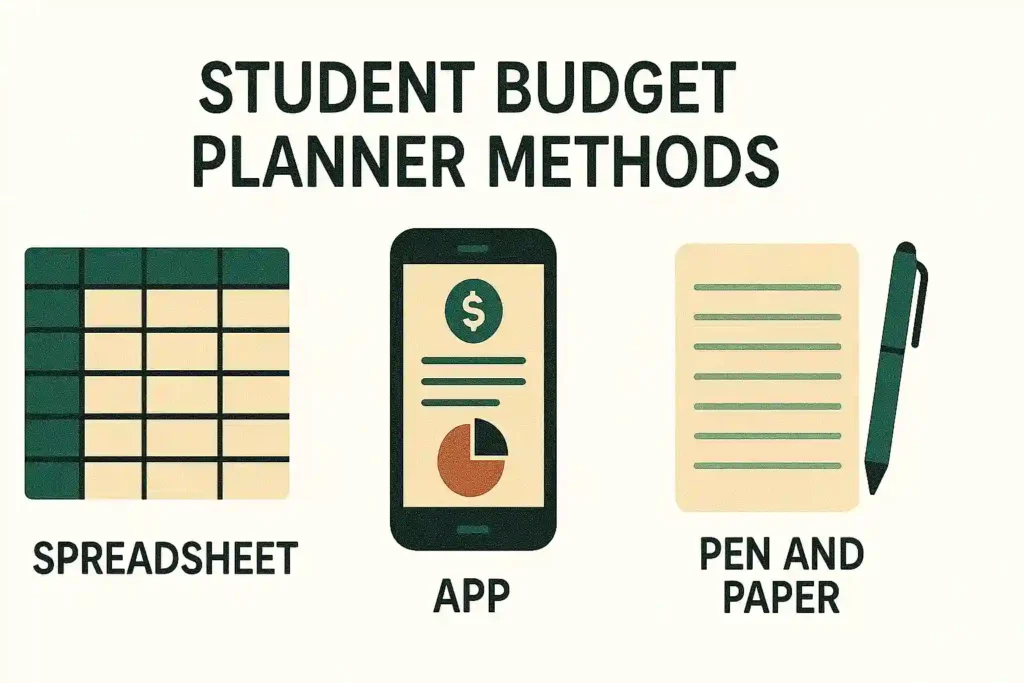Let’s define our term: A student budget planner is essentially a tool or system designed specifically to help students track their income, manage expenses, and plan their spending according to their financial goals while navigating the unique challenges of student life. Feeling the pinch? Constantly worried about making your loan disbursement last? Living on instant ramen more often than you’d like? You’re not alone! Managing money as a student can feel like juggling flaming torches while riding a unicycle. But what if you could ditch the stress, gain control, and actually have enough money for both essentials and some fun? This comprehensive guide provides everything you need – from understanding your finances to choosing the right tools and implementing practical strategies. Get ready to master your money with your very own effective student budget planner system!
Table of Contents
Why Every Student Absolutely Needs a Budget Planner (Seriously!)
Thinking budgeting is boring or only for “real adults”? Think again! For students, having a budget planner isn’t just helpful; it’s practically essential. Here’s why:
- Avoid Unnecessary Debt: Understanding where your money goes helps prevent overspending and relying too heavily on credit cards or overdrafts.
- Reduce Financial Stress: Knowing you have a plan for your money significantly reduces anxiety about bills, rent, and unexpected costs. Financial peace of mind is priceless during stressful study periods.
- Achieve Your Goals: Want to save for a spring break trip, a new laptop, or just avoid calling home for cash? A budget planner helps you allocate funds towards what truly matters to you.
- Build Lifelong Financial Habits: Learning to manage money effectively now sets you up for financial success long after graduation. It’s a crucial life skill.
- Make Informed Decisions: Should you take that part-time job? Can you afford that concert ticket? A budget gives you the data to decide wisely.
- Maximize Limited Resources: Let’s face it, most students aren’t rolling in cash. A budget helps you make the absolute most of the money you do have from loans, jobs, or family.
Step 1: Gather Your Financial Information (Know Your Numbers)
You can’t plan if you don’t know your starting point. This first step is all about getting clarity on your income and spending habits. Be honest with yourself!
Identify ALL Your Income Sources
Where is money coming from? List everything, even if it’s irregular:
- Student Loans: Note the total amount disbursed per semester/year and when you receive it.
- Grants & Scholarships: Money you don’t have to repay – fantastic!
- Parental/Family Contributions: Regular allowances or occasional help.
- Part-Time Job Wages: Estimate your average monthly take-home pay (after taxes).
- Personal Savings: Any money you brought with you to university.
- Other Sources: Side hustles, selling items, etc.
Pro Tip: If your income is irregular (e.g., variable part-time hours), try to estimate conservatively based on your lowest likely monthly earnings, or average it out over a few months.
Track Your Expenses (The Eye-Opening Part!)
This is often the most crucial step. For at least two weeks (a full month is even better!), meticulously track every single dollar you spend. Seriously – every coffee, bus ticket, online purchase. This reveals your actual spending patterns, which might surprise you!
Use a notebook, a spreadsheet, or a tracking app. Common student expense categories include:
- Tuition & Fees: Often paid per semester/year.
- Books & Supplies: Textbooks, notebooks, software, lab fees.
- Housing: Rent, dorm fees, potentially utilities (electricity, water, gas).
- Food: Groceries, dining hall plans, eating out, coffee shops.
- Transportation: Public transport passes, gas, car insurance/maintenance (if applicable), ride-sharing.
- Phone & Internet Bills.
- Personal Care: Toiletries, haircuts, etc.
- Entertainment & Social Life: Movies, concerts, nights out, hobbies, sports.
- Clothing & Shopping.
- Subscriptions: Streaming services, gym memberships, software subs.
- Miscellaneous: Gifts, unexpected costs, bank fees.
Step 2: Choose Your Student Budget Planner Method
There’s no single “best” way to budget; the best method is the one you’ll actually stick with! Consider these options:

The Classic Spreadsheet (Excel/Google Sheets)
- Pros: Highly customizable, free (Google Sheets), great for visualizing data with charts, excellent for detailed tracking. Many find creating their own student budget planner template empowering.
- Cons: Requires manual input (can be tedious), need discipline to update regularly, less convenient on the go unless using mobile apps.
Budgeting Apps Designed for Students (Or Great General Ones)
- Pros: Often automate transaction tracking by linking to bank accounts, categorize spending automatically, provide real-time updates and spending alerts, convenient mobile access. Some apps are specifically tailored to student needs.
- Cons: Some apps have subscription fees (look for free versions!), potential privacy concerns (linking bank accounts), might require customization to fit student expense categories perfectly.
- Examples (Categories): Look for apps focused on simple tracking, goal setting, or envelope budgeting principles.
The Pen-and-Paper Method (Simple & Tangible)
- Pros: Very simple, low-tech, physically writing things down can increase awareness, no apps or software needed. You can buy dedicated budget planners or just use a notebook.
- Cons: Entirely manual, requires carrying it with you or remembering expenses, harder to analyze trends over time, prone to calculation errors.
Popular Budgeting Rules Adapted for Students
These aren’t standalone planners, but frameworks you can apply within your chosen method:
- The 50/30/20 Rule (Student Edition): Aim for 50% Needs (tuition share, rent, essential groceries, transport), 30% Wants (entertainment, eating out, hobbies), 20% Savings/Debt Goals (emergency fund, saving for a specific goal, extra loan payments if applicable). Note: Student ‘Needs’ might look different, especially if tuition is covered by loans/grants initially. Adjust percentages based on your situation.
- Zero-Based Budgeting: Give every dollar of your income a specific job (category). Income minus all allocated expenses should equal zero. Very intentional, forces you to account for everything.
Step 3: Create Your Budget – Assigning Your Dollars
Now it’s time to build your actual budget using the info gathered and your chosen method.
- Estimate Your Monthly Income: Based on Step 1, figure out your total expected income for the month. If it varies, use a conservative estimate. If you get large loan disbursements, divide the amount by the number of months it needs to cover.
- Allocate Funds to Fixed Expenses: These are costs that are generally the same each month (rent/dorm fees, scheduled tuition payments, phone bill, known subscription costs, set loan payments if any). Subtract these from your total income.
- Allocate Funds to Variable Expenses: This is where your expense tracking helps! Look at your averages for categories like groceries, transportation, entertainment, personal care. Set realistic spending limits for each category based on the remaining income. Be honest about your social life needs, but be intentional.
- Prioritize Savings & Debt Repayment Goals: Don’t treat savings as an afterthought! Allocate specific amounts, even small ones, towards:
- An Emergency Fund (aim for $500-$1000 initially for student-specific emergencies).
- Short-term goals (e.g., saving for a deposit, new tech).
- Potential extra payments on high-interest debt (like credit cards, though focus may be on studies).
- Calculate the Difference (Income – Expenses = ?): Subtract all your allocated fixed expenses, variable expense limits, and savings goals from your total income.
- If Positive (+): Great! You have extra. Allocate it to savings, debt, or a specific goal.
- If Negative (-): You’ve budgeted to spend more than you earn. You MUST go back and reduce spending limits in variable categories (Wants first!) until you reach zero or positive.
- If Zero (0): You’ve achieved a zero-based budget! Every dollar has a job.
This process requires tweaking. Your first attempt won’t be perfect!
Step 4: Track Consistently & Adjust Your Plan (Budgeting Isn’t One-and-Done!)
Creating the budget planner is just the start. The real magic happens when you use it consistently.
Regular Check-ins (Weekly/Monthly)
Set aside time each week (maybe Sunday evening) or at least monthly to:
- Record your actual spending in each category.
- Compare your actual spending to your budgeted amounts.
- See where you succeeded and where you overspent.
This keeps you accountable and helps you understand your habits in real-time. If you use an app, this might be largely automated, but still review the summaries.
Making Adjustments (Life Happens!)
Your budget isn’t set in stone. Life throws curveballs – an unexpected textbook cost, a flat tire, maybe you earned less than expected. A good budget is flexible.
- If you overspend in one category, try to compensate by spending less in another (usually a ‘Want’ category).
- If a significant unexpected expense occurs, you might need to dip into your emergency fund (that’s what it’s for!) and then rebuild it.
- If your income changes, adjust your entire budget accordingly.
Reviewing Your student weekly budget plan
If you prefer breaking things down further, create a student weekly budget plan based on your monthly allocations. Divide monthly variable limits (like groceries, entertainment) by four. This can provide tighter control, especially if you get paid weekly or struggle with monthly planning.
Top Student Money Saving Tips (Beyond the Budget Planner)
Your budget planner helps manage money, but actively saving requires smart choices. Here are some top student money saving tips:

- Textbooks: NEVER buy new if you can avoid it! Explore used books (campus groups, online marketplaces), rentals (Chegg, Amazon), library copies, or sharing with classmates.
- Student Discounts: ALWAYS ask! Use sites like UNiDAYS, Student Beans, or your official student ID for discounts on food, clothes, tech, travel, software, and more.
- Cook More, Eat Out Less: Restaurant meals and takeaways drain budgets fast. Plan simple, cheap meals for students budget, cook in batches, pack lunches.
- DIY Coffee/Tea: That daily latte habit adds up significantly. Brew at home.
- Leverage Free Entertainment: Check out free campus events, movie nights, museum free days, parks, hiking, library resources.
- Smart Transportation: Walk, bike, or use public transport instead of ride-sharing or driving whenever possible.
- Subscription Audit: Regularly review streaming services, apps, and gym memberships. Cancel anything you don’t use often. Share accounts where allowed.
- The 24-Hour Rule: For non-essential purchases, wait 24 hours before buying. Often, the impulse fades.
- Earn Extra Cash: Consider a flexible part-time job, tutoring, participating in paid research studies, freelancing online, or selling unused items.
Dealing with Student Loans in Your Budget
Student loans are a common part of student finance, but they require careful management within your budget planner.
- Budget Before You Spend: When you receive a large loan disbursement, don’t treat it like free money! Immediately allocate it within your budget for the entire semester/year it needs to cover (tuition, fees, housing, living expenses). Put the bulk of it aside in a savings account and transfer monthly amounts to your checking account as per your budget.
- Understand Your Loans: Know the types of loans you have (federal vs. private), their interest rates, and when repayment begins. Resources like the US Department of Education’s StudentAid.gov website (https://studentaid.gov/) are invaluable. (Check for your country’s equivalent government resource).
- Plan for Repayment: Even while studying, start thinking about repayment. Understand grace periods and potential repayment plan options. Budgeting now makes the transition smoother later.
Helpful Resources for Student Budgeting
Don’t go it alone! Utilize these resources:
- Your University’s Financial Aid Office: They often provide workshops, counseling, emergency aid information, and sometimes even budgeting tools or templates. Check their website!
- Government Student Finance Websites: Sites like StudentAid.gov (US) (https://studentaid.gov/), gov.uk/student-finance (UK), canada.ca/student-financial-assistance (Canada) offer crucial information on loans, grants, and repayment.
- Non-Profit Financial Literacy Organizations: Groups like the National Endowment for Financial Education (NEFE) (https://www.nefe.org/) or Jump$tart Coalition offer unbiased educational resources and tools.
- Reputable Budgeting Blogs & Apps: Look for those focused on beginner or student finance (but be wary of constant upselling).
Conclusion: Your Path to Financial Confidence as a Student
Creating and sticking to a student budget planner is one of the most empowering steps you can take during your academic career. It transforms money from a source of stress into a tool you control. By understanding your income, tracking your expenses, choosing a method that works for you, setting realistic limits, and consistently reviewing your progress, you build invaluable skills and financial resilience.
It won’t always be perfect. There will be times you overspend or face unexpected costs. The key is flexibility, learning from mistakes, and getting back on track. Start today, even if it’s just tracking your spending for a week. Taking that first step is the most important one on your path to financial confidence and freedom as a student.
Frequently Asked Questions (FAQ)
Q1: How do I make a student budget if my income is irregular (e.g., part-time job with varying hours)? A: Great question! The key is to budget based on your lowest expected income for the month. Create a baseline budget covering essentials with that amount. Any income you earn above that minimum can then be allocated strategically – perhaps towards savings goals, paying down debt faster, or adding a bit more to flexible spending categories like entertainment. Alternatively, calculate your average monthly income over the past few months and budget based on that, but always keep a buffer in savings for slower months.
Q2: What’s a realistic amount for a student’s weekly or monthly budget? A: This varies HUGELY depending on location (cost of living), accommodation type (dorm vs. off-campus), lifestyle, income sources, and tuition costs. There’s no magic number. The only way to know what’s realistic for you is to track your expenses (Step 1) and build your own budget (Step 3) based on your actual income and essential costs. Focus on creating a budget where your income covers your planned spending and saving, rather than comparing to others.
Q3: Should I prioritize saving money or paying off student loans while I’m still studying? A: Generally, while studying, the priority should be building a small emergency fund (e.g., $500-$1000) for immediate needs. Most student loans (especially federal ones) don’t require repayment until after graduation (check your specific loan terms!). Focus on covering current expenses and building that safety net. Aggressively paying down loans usually makes more sense after you graduate and have a stable income, unless you have private loans with very high variable interest rates already accruing.
Q4: Are budgeting apps better than spreadsheets for students? A: Neither is inherently “better” – it depends on your personality and preferences! Apps offer convenience, automation, and mobile access, which many students love. Spreadsheets offer ultimate control, customization, and are free. Try both! Use a spreadsheet for initial detailed planning and maybe an app for daily tracking, or just stick with the method you find easiest to maintain consistently.
Q5: How often should I update or review my student budget planner? A: You should track your spending regularly (daily or every few days is ideal via an app or quick note). Then, do a proper review and comparison against your budget at least once a week or bi-weekly. Definitely do a full review and adjustment session at least once a month. Also, revisit your budget whenever a major financial change occurs (new job, rent increase, change in financial aid, etc.).



